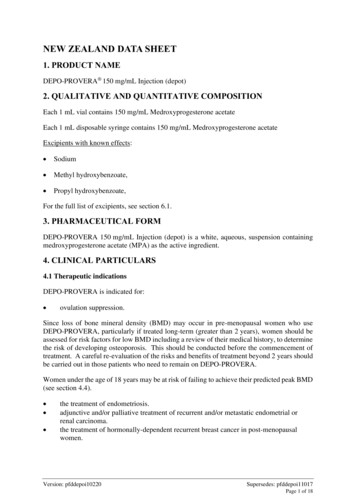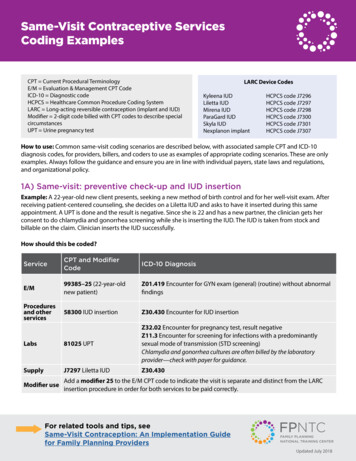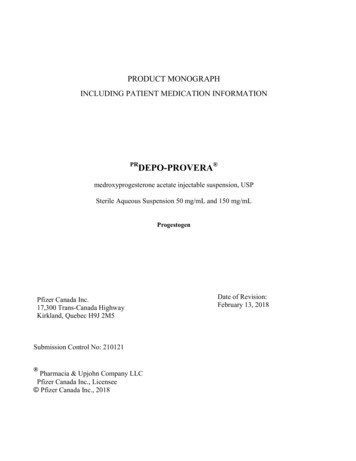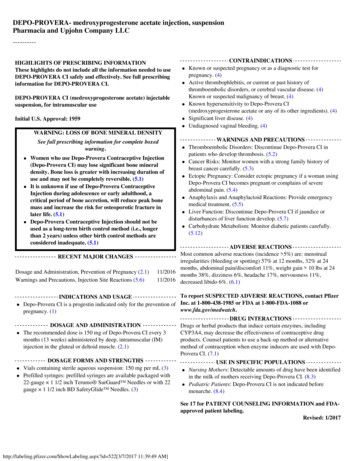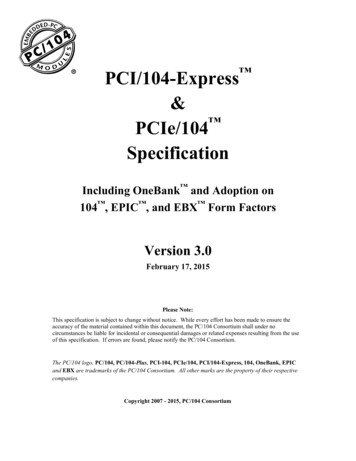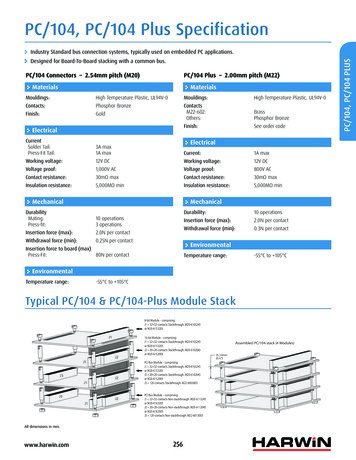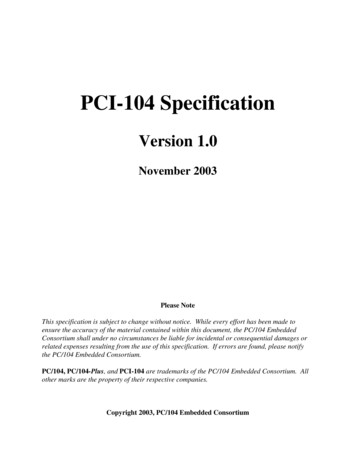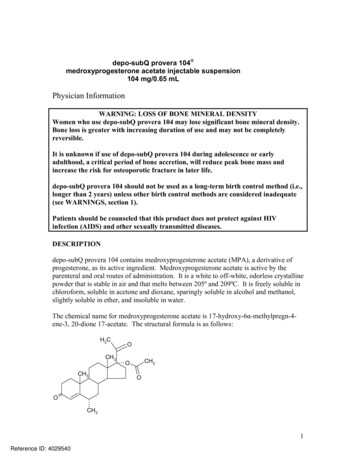
Transcription
depo-subQ provera 104 medroxyprogesterone acetate injectable suspension104 mg/0.65 mLPhysician InformationWARNING: LOSS OF BONE MINERAL DENSITYWomen who use depo-subQ provera 104 may lose significant bone mineral density.Bone loss is greater with increasing duration of use and may not be completelyreversible.It is unknown if use of depo-subQ provera 104 during adolescence or earlyadulthood, a critical period of bone accretion, will reduce peak bone mass andincrease the risk for osteoporotic fracture in later life.depo-subQ provera 104 should not be used as a long-term birth control method (i.e.,longer than 2 years) unless other birth control methods are considered inadequate(see WARNINGS, section 1).Patients should be counseled that this product does not protect against HIVinfection (AIDS) and other sexually transmitted diseases.DESCRIPTIONdepo-subQ provera 104 contains medroxyprogesterone acetate (MPA), a derivative ofprogesterone, as its active ingredient. Medroxyprogesterone acetate is active by theparenteral and oral routes of administration. It is a white to off-white, odorless crystallinepowder that is stable in air and that melts between 205º and 209ºC. It is freely soluble inchloroform, soluble in acetone and dioxane, sparingly soluble in alcohol and methanol,slightly soluble in ether, and insoluble in water.The chemical name for medroxyprogesterone acetate is 17-hydroxy-6α-methylpregn-4ene-3, 20-dione 17-acetate. The structural formula is as follows:H3CCH3CH3OCH3OOOCH31Reference ID: 4029540
depo-subQ provera 104 for subcutaneous (SC) injection is available in pre-filled syringes(160 mg/mL), each containing 0.65 mL (104 mg) of medroxyprogesterone acetate sterileaqueous suspension.Each 0.65 mL contains:Medroxyprogesterone acetate104 mgMethylparaben1.040 mgPropylparaben0.098 mgSodium Chloride5.200 mgPolyethylene Glycol18.688 mgPolysorbate 801.950 mgMonobasic Sodium Phosphate . H2O0.451 mg.Dibasic Sodium Phosphate 12H2O0.382 mgMethionine0.975 mgPovidone3.250 mgWater for InjectionqsWhen necessary, the pH is adjusted with sodium hydroxide or hydrochloric acid, or both.CLINICAL PHARMACOLOGYdepo-subQ provera 104 (medroxyprogesterone acetate injectable suspension), whenadministered at 104 mg/0.65 mL to women every 3 months (12 to 14 weeks), inhibits thesecretion of gonadotropins, which prevents follicular maturation and ovulation andcauses endometrial thinning. These actions produce its contraceptive effect.Supression of serum estradiol concentrations and a possible direct action of depo-subQprovera 104 on the lesions of endometriosis are likely to be responsible for thetherapeutic effect on endometriosis-associated pain.PharmacokineticsThe pharmacokinetic parameters of medroxyprogesterone acetate (MPA) following asingle SC injection of depo-subQ provera 104 are shown in Table 1 and Figure 1.2Reference ID: 4029540
Table 1. Pharmacokinetic Parameters of MPAafter a Single SC Injection of depo-subQ provera 104 in Healthy Women(n )66.9820.63139.79AUC0– (ng·day/mL)92.8431.36162.29t½(day)4316114Cmax peak serum concentration; Tmax time when Cmax is observed; C91 serumconcentration at 91 days; AUC0–91 and AUC0– area under the concentration-timecurve over 91 days or infinity, respectively; t½ terminal half-lifeAbsorption: Following a single SC injection of depo-subQ provera 104, serum MPAconcentrations reach 0.2 ng/mL within 24 hours. The mean Tmax is attainedapproximately 1 week after injection.Figure 1. Mean (SD) Serum Concentration-Time Profile of MPAafter a Single Injection of depo-subQ provera 104 to HealthyWomenMPA Serum Concentration (ng/mL)21.510.500306090120150Time (Days)In a study to assess accumulation and the achievement of steady state following multipleSC administrations, trough concentrations of MPA were determined after 6, 12, and 24months, and in a subset of 8 subjects, bi-weekly concentrations were determined withinone dosing interval in the second year of administration. The mean (SD) MPA troughconcentrations were 0.67 (0.36) ng/mL (n 157), 0.79 (0.36) ng/mL (n 144), and 0.87(0.33) ng/mL (n 106) at 6, 12 and 24 months, respectively.3Reference ID: 4029540
Effect of Injection Site: depo-subQ provera 104 was administered into the anterior thighor the abdomen to evaluate effects on the MPA concentration-time profile. MPA troughconcentrations (Cmin; Day 91) were similar for the two injection locations.Distribution: Plasma protein binding of MPA averages 86%. MPA binding occursprimarily to serum albumin. No binding of MPA occurs with sex-hormone-bindingglobulin (SHBG).Metabolism: MPA is extensively metabolized in the liver by P450 enzymes. Itsmetabolism primarily involves ring A and/or side-chain reduction, loss of the acetylgroup, hydroxylation in the 2-, 6-, and 21-positions or a combination of these positions,resulting in more than 10 metabolites.Excretion: Residual MPA concentrations at the end of the first dosing interval (12 to 14weeks) of depo-subQ provera 104 are generally below 0.5 ng/mL, consistent with itsapparent terminal half-life of 40 days after SC administration. Most MPA metabolitesare excreted in the urine as glucuronide conjugates with only small amounts excreted assulfates.Linearity/Non-Linearity: Following a single SC administration of doses ranging from 50to 150 mg, the AUC and Cmin (Day 91) increased with higher doses of depo-subQ provera104, but there was considerable overlap across dose levels. Serum MPA concentrationsat Day 91 increased in a dose proportional manner but Cmax did not appear to increaseproportionally with increasing dose. The AUC data were suggestive of dose linearity.Special PopulationsRace: There were no significant differences in the pharmacokinetics and/orpharmacodynamics of MPA after SC administration of depo-subQ provera 104 inAfrican-American and Caucasian women. The pharmacokinetics/pharmacodynamics ofdepo-subQ provera 104 were evaluated in Asian women in a separate study and alsofound to be similar to African-American and Caucasian women.Effect of Body Weight: Although total MPA exposure was lower in obese women, nodosage adjustment of depo-subQ provera 104 is necessary based on body weight. Theeffect of body weight on the pharmacokinetics of MPA following a single dose wasassessed in a subset of women (n 42, body mass index [BMI] ranged from 18.2 to 46.7kg/m2). The AUC0–91 values for MPA were 71.6, 67.9, and 46.3 ng·day/mL in womenwith BMI categories of 28 kg/m2, 28–38 kg/m2, and 38 kg/m2, respectively. Themean MPA Cmax was 1.74 ng/mL in women with BMI 28 kg/m2, 1.53 ng/mL in womenwith BMI 28–38 kg/m2, and 1.02 ng/mL in women with BMI 38 kg/m2, respectively.The MPA trough (Cmin) concentrations had a tendency to be lower in women with BMI 38 kg/m2.4Reference ID: 4029540
Hepatic Insufficiency: No clinical studies have evaluated the effect of hepatic diseaseon the disposition of depo-subQ provera 104. However, steroid hormones may be poorlymetabolized in patients with severe liver dysfunction (see CONTRAINDICATIONS).Renal Insufficiency: No clinical studies have evaluated the effect of renal disease on thepharmacokinetics of depo-subQ provera 104.Drug-Drug InteractionsSee PRECAUTIONS, section 9INDICATIONS AND USAGEdepo-subQ provera 104 is indicated for the prevention of pregnancy in women of childbearing potential.depo-subQ provera 104 also is indicated for management of endometriosis-associatedpain.In considering use for either indication, the loss of bone mineral density (BMD) inwomen of all ages and the impact on peak bone mass in adolescents should beconsidered, along with the decrease in BMD that occurs during pregnancy and/orlactation, in the risk/benefit assessment for women who use depo-subQ provera 104 longterm (see WARNINGS, section 1).Contraception StudiesIn three clinical studies, no pregnancies were detected among 2,042 women using deposubQ provera 104 for up to 1 year. The Pearl Index pregnancy rate in women who wereless than 36 years old at baseline, based on cycles in which they used no othercontraceptive methods, was 0 pregnancies per 100 women-years of use (upper 95%confidence interval 0.25).Pregnancy rates for various contraceptive methods are typically reported for only the firstyear of use and are shown in Table 2.5Reference ID: 4029540
Table 2. Percentage of Women Experiencing an Unintended Pregnancy During theFirst Year of Typical Use and the First Year of Perfect Use of Contraceptionand the Percentage Continuing Use at the End of the First Year: United States% of Women Experiencing an UnintendedPregnancy within the First Year of Use% of WomenContinuing Use at 1Year3MethodTypical Use1Perfect Use2Chance48585Spermicides526640Periodic Abstinence2563Calendar9Ovulation Method3Symptothermal62Post-ovulation1Cap7Parous Women402642Nulliparous Women20956SpongeParous Women402042Nulliparous e (Reality)21556Male14361Pill571Progestin only0.5Combined0.1IUDProgesterone T2.01.581Copper T 380A0.80.678LNg 200.10.181Depo-Provera IM 150 mg0.30.370Norplant and Norplant-20.050.0588Female Sterilization0.50.5100Male Sterilization0.150.10100Emergency Contraceptive Pills: Treatment initiated within 72 hours after unprotected intercoursereduces the risk of pregnancy by at least 75%.9Lactational Amenorrhea Method: LAM is a highly effective, temporary method of contraception.10Source: Hatcher et al., 1998.i1Among typical couples who initiate use of a method (not necessarily for the first time), the percentage who experiencean accidental pregnancy during the first year if they do not stop use for any other reason.2Among couples who initiate use of a method (not necessarily for the first time) and who use it perfectly (bothconsistently and correctly), the percentage who experience an accidental pregnancy during the first year if they do notstop use for any other reason.3Among couples attempting to avoid pregnancy, the percentage who continue to use a method for 1 year.4The percentages becoming pregnant in columns (2) and (3) are based on data from populations where contraception isnot used and from women who cease using contraception in order to become pregnant. Among such populations, about89% become pregnant within 1 year. This estimate was lowered slightly (to 85%) to represent the percentages whowould become pregnant within 1 year among women now relying on reversible methods of contraception if theyabandoned contraception altogether.6Reference ID: 4029540
5Foams, creams, gels, vaginal suppositories, and vaginal film.Cervical mucus (ovulation) method supplemented by calendar in the pre-ovulatory and basal body temperature in thepost-ovulatory phases.7With spermicidal cream or jelly.8Without spermicides.9The treatment schedule is one dose within 72 hours after unprotected intercourse, and a second dose 12 hours after thefirst dose. The Food and Drug Administration has declared the following brands of oral contraceptives to be safe andeffective for emergency contraception: Ovral (1 dose is 2 white pills), Alesse (1 dose is 5 pink pills), Nordette orLevlen (1 dose is 4 light-orange pills), Lo/Ovral (1 dose is 4 white pills), Triphasil or Tri-Levlen (1 dose is 4 yellowpills).10However, to maintain effective protection against pregnancy, another method of contraception must be used as soonas menstruation resumes, the frequency or duration of breastfeeds is reduced, bottle feeds are introduced, or the babyreaches 6 months of age.6Endometriosis StudiesThe efficacy of depo-subQ provera 104 in the reduction of endometriosis-associated painin women with the signs and symptoms of endometriosis was demonstrated in two activecomparator-controlled studies. Each study assessed reduction in endometriosis-associatedpain over 6 months of treatment and recurrence of symptoms for 12-months posttreatment. Subjects treated with depo-subQ provera 104 for 6 months received a 104 mgdose every 3 months (2 injections), while women treated with leuprolide microspheresfor 6 months received a dose of 11.25 mg every 3 months (2 injections) or 3.75 mg everymonth (6 injections). Study 268 was conducted in the U.S. and Canada and enrolled 274subjects (136 on depo-subQ provera 104 and 138 on leuprolide). Study 270 wasconducted in South America, Europe and Asia, and enrolled 299 subjects (153 on deposubQ provera 104 and 146 on leuprolide).Reduction in pain was evaluated using a modified Biberoglu and Behrman scale thatconsisted of three patient-reported symptoms (dysmenorrhea, dyspareunia, and pelvicpain not related to menses) and two signs assessed during pelvic examination (pelvictenderness and induration). For each category, a favorable response was defined asimprovement of at least 1 unit (severity was assessed on a scale of 0 to 3) relative tobaseline score (Figure 2).7Reference ID: 4029540
Figure 2. Percentages of Responders at End of Treatment (Month 6 orLast Assessment if Earlier) in Studies 268 & 270Study 268: depo-subQ provera 104 (N 136)Study 268:leuprolide (N 138)Study 270:depo-subQ provera 104 (N 153)Study 270:leuprolide (N 0Favorable Response reduction in severity of symptom or sign of 1 point on a scale of 0 to 3, ascompared to baselineAdditionally, scores from each of the five categories were combined, with the total(composite score) considered a global measurement of overall disease improvement. Forsubjects with baseline scores for each of the 5 categories, a mean decrease of 4 pointsrelative to baseline was considered a clinically meaningful improvement. Across bothstudies, for both treatment groups, the mean changes in the composite score met theprotocol-defined criterion for improvement.In the clinical trials, treatment with depo-subQ provera 104 was limited to six months.Data on the persistence of benefit with longer treatment are not available.Subjects recorded daily the occurrence and severity of hot flushes. Of the depo-subQprovera 104 users, 28.6% reported experiencing moderate or severe hot flushes atbaseline, 36.2% at month 3, and 26.7% at month 6. Of the leuprolide users, 32.8%reported experiencing moderate or severe hot flushes at baseline, 74.2% at month 3, and68.5% at month 6.CONTRAINDICATIONS1.2.3.4.Known or suspected pregnancy.Undiagnosed vaginal bleeding.Known or suspected malignancy of the breast.Active thrombophlebitis, or current or past history of thromboembolic disorders, orcerebral vascular disease.8Reference ID: 4029540
5. Significant liver disease.6. Known hypersensitivity to medroxyprogesterone acetate or any of its otheringredients.WARNINGS1. Loss of Bone Mineral DensityUse of depo-subQ provera 104 reduces serum estrogen levels and is associated withsignificant loss of bone mineral density (BMD). This loss of BMD is of particularconcern during adolescence and early adulthood, a critical period of bone accretion.It is unknown if use of depo-subQ provera 104 by younger women will reduce peakbone mass and increase the risk for osteoporotic fracture in later life.A study to assess the reversibility of loss of BMD in adolescents was conducted withDepo-Provera CI (150 mg medroxyprogesterone acetate IM, DMPA). Afterdiscontinuing Depo-Provera CI in adolescents, mean BMD loss at total hip andfemoral neck did not fully recover by 60 months (240 weeks) post-treatment.Similarly, in adults, there was only partial recovery of mean BMD at total hip,femoral neck and lumbar spine towards baseline by 24 months post-treatment.depo-subQ provera 104 should not be used as a long-term birth control method(i.e., longer than 2 years) unless other birth control methods are consideredinadequate. BMD should be evaluated when a woman needs to continue to usedepo-subQ provera 104 long-term. In adolescents, interpretation of BMD resultsshould take into account patient age and skeletal maturity.Other birth control methods should be considered in the risk/benefit analysis for theuse of depo-subQ provera 104 in women with osteoporosis risk factors. depo-subQprovera 104 can pose an additional risk in patients with risk factors for osteoporosis(e.g., metabolic bone disease, chronic alcohol and/or tobacco use, anorexia nervosa,strong family history of osteoporosis or chronic use of drugs that can reduce bonemass such as anticonvulsants or corticosteroids). Although there are no studiesaddressing whether calcium and Vitamin D lessen BMD loss in women using deposubQ provera 104, all patients should have adequate calcium and Vitamin D intake.BMD Changes in Adult Women after Long-Term Treatment for ContraceptionA study comparing changes in BMD in women using depo-subQ provera 104 withwomen using Depo-Provera Contraceptive Injection (Depo-Provera CI, 150 mg) showedno significant differences in BMD loss between the two groups after two years oftreatment. Mean percent changes in BMD in the depo-subQ provera 104 group are listedin Table 3.9Reference ID: 4029540
Table 3. Mean Percent Change from Baseline in BMD in Women Using depo-subQprovera 104Lumbar SpineTime onTreatmentTotal HipFemoral NeckNMean % Change(95% CI)NMean % Change(95% CI)NMean % Change(95% CI)1 year166-2.7(-3.1 to -2.3)166-1.7(-2.1 to -1.3)166-1.9(-2.5 to -1.4)2 year106- 4.1(-4.6 to -3.5)106-3.5(-4.2 to -2.7)106-3.5(-4.3 to -2.6)In another controlled clinical study, adult women using Depo-Provera CI (150 mg) for upto 5 years showed spine and hip BMD mean decreases of 5–6%, compared to nosignificant change in BMD in the control group. The decline in BMD was morepronounced during the first two years of use, with smaller declines in subsequent years.Mean changes in lumbar spine BMD of –2.86%, -4.11%, -4.89%, -4.93% and –5.38%after 1, 2, 3, 4 and 5 years, respectively, were observed. Mean decreases in BMD of thetotal hip and femoral neck were similar.After stopping use of Depo-Provera CI (150 mg) there was partial recovery of BMDtoward baseline values during the 2-year post-therapy period. Longer duration oftreatment was associated with less complete recovery during this 2-year period followingthe last injection. Table 4 shows the change in BMD in women after 5 years oftreatment with Depo-Provera CI and in women in a control group, as well as the extentof recovery of BMD for the subset of the women for whom 2-year post treatment datawere available.Table 4. Mean Percent Change from Baseline in BMD in Adults by Skeletal Site andCohort (5 Years of Treatment and 2 Years of Follow-Up)Time in StudySpineTotal HipFemoral NeckDepo- Control** Depo- Control** DepoControl**Provera *Provera *Provera *5 years-5.38%n 330.43%n 105-5.16%n 210.19%n 65-6.12%n 34-0.27%n 1067 years-3.13%n 120.53%n 60-1.34%n 70.94%n 39-5.38%n 13-0.11%n 63*The treatment group consisted of women who received Depo-Provera CI (150 mg) for 5 years and werethen followed for 2 years post-use (total time in study of 7 years).10Reference ID: 4029540
**The control group consisted of women who did not use hormonal contraception and were followed for7 years.Bone Mineral Density Changes in Adolescent Females (12–18 years of age)The impact of Depo-Provera CI (150 mg) use for up to 240 weeks (4.6 years) wasevaluated in an open-label non-randomized clinical study in 389 adolescent females(12-18 years). Use of Depo-Provera CI was associated with a significant decline frombaseline in BMD.Partway through the trial, drug administration was stopped (at 120 weeks). The meannumber of injections per Depo-Provera CI user was 9.3. The decline in BMD at total hipand femoral neck was greater with longer duration of use (see Table 5). The meandecrease in BMD at 240 weeks was more pronounced at total hip (-6.4%) and femoralneck (-5.4%) compared to lumbar spine (-2.1%).In general, adolescents increase bone density during the period of growth followingmenarche, as seen in the untreated cohort. However, the two cohorts were not matched atbaseline for age, gynecologic age, race, BMD and other factors that influence the rate ofacquisition of bone mineral density.Table 5. Mean Percent Change from Baseline in BMD in Adolescents Receiving 4 Injections per 60-week Period, by Skeletal Site and CohortDuration ofTreatmentTotal Hip BMDWeek 60 (1.2 years)Week 120 (2.3 years)Week 240 (4.6 years)Femoral Neck BMDWeek 60Week 120Week 240Lumbar Spine BMDWeek 60Week 120Week 240Depo-Provera CI(150 mg IM)Unmatched, UntreatedCohortNMean % ChangeNMean % 47-2.74-2.11167109843.395.286.40BMD recovery post-treatment in adolescent womenLonger duration of treatment and smoking were associated with less recovery of BMDfollowing the last injection of Depo-Provera CI. Table 6 shows the extent of recoveryof BMD up to 60 months post-treatment for adolescent women who received DepoProvera CI for two years or less compared to more than two years. Post-treatmentfollow-up showed that, in women treated for more than two years, only lumbar spineBMD recovered to baseline levels after treatment was discontinued. Subjects treatedwith Depo-Provera for more than two years did not recover to their baseline BMD level11Reference ID: 4029540
at femoral neck and total hip even up to 60 months post-treatment. Adolescent womenin the untreated cohort gained BMD throughout the trial period (data not shown).Table 6: Extent of BMD Recovery (Months Post-Treatment) in Adolescents byYears of Depo Provera CI Use (2 Years or Less vs. More than 2 Years)Duration of2 years or lessMore than 2 yearsTreatmentNMean % ChangeNMean % Changefrom baselinefrom baselineTotal Hip BMD49-1.5%49-6.2%End of Treatment12 M post-treatment24 M post-treatment36 M post-treatment48 M post-treatment60 M post-treatment331812103End of Treatment12 M post-treatment24 M post-treatment36 M post-treatment48 M post-treatment60 M post-treatment49331812103End of Treatment12 M post-treatment24 M post-treatment36 M post-treatment48 M post-treatment60 M %5.7%Femoral Neck BMD-1.6%-1.4%0.5%1.2%2.0%1.0%Lumbar Spine BMD-0.9%0.4%2.6%2.4%6.5%6.2%BMD Changes in Adult Women after Six Months of Treatment for EndometriosisIn two clinical studies of 573 adult women with endometriosis, the BMD effects of 6months of depo-subQ provera 104 treatment were compared to 6 months of leuprolidetreatment. Subjects were then observed, off therapy, for an additional 12 months(Table 7).12Reference ID: 4029540
Table 7. Mean Percent Change from Baseline in BMD after 6 Months on Therapy withdepo-subQ provera 104 or Leuprolide and 6 and 12 Months after Stopping Therapy(Studies 268 and 270 Combined)Lumbar SpineTime of Measurementdepo-subQ provera104Total HipLeuprolidedepo-subQ provera104LeuprolideNMean %changeNMean %changeNMean %changeNMean %changeMonth 6 oftreatment (EOT)208-1.20229-4.10207-0.03227-1.836 months offtreatment168-1.06180-2.75169-0.05181-1.5912 months offtreatment124-0.54133-1.481250.39134-1.15EOT End of Treatment2. Bleeding IrregularitiesMost women using depo-subQ provera 104 experienced changes in menstrual bleedingpatterns, such as amenorrhea, irregular spotting or bleeding, prolonged spotting orbleeding, and heavy bleeding. As women continued using depo-subQ provera 104, fewerexperienced irregular bleeding and more experienced amenorrhea. If abnormal bleedingis persistent or severe, appropriate investigation and treatment should be instituted.In three contraception trials, 39.0 % of women experienced amenorrhea during monthsix, and 56.5% experienced amenorrhea during month 12. The changes in menstrualbleeding patterns from the three contraception trials are presented in Figures 3 and 4.13Reference ID: 4029540
Figure 3. Percentages of depo-subQ provera 104 Treated Women with Amenorrheaper 30-Day Month in Contraception Studies (ITT Population, N 404121273MonthN Number of subjects in analysis for indicated monthFigure 4. Mean (25th, 75th Percentiles) Number of Bleeding and/or Spotting Days inthe Subgroup of Women with Bleeding and/or Spotting by Month for WomenTreated with depo-subQ provera 104 in Contraception StudiesMean (25th, 75th Percentiles) Number of DaysBleeding and/or 30772487619734105371158012554MonthN Number of subjects with bleeding and/or spotting during indicated month14Reference ID: 4029540
The changes in menstrual patterns in the two endometriosis trials are presented in Figures5 and 6.Figure 5. Percentages of depo-subQ provera 104 Treated Women with Amenorrheaper 30-Day Month in Endometriosis Studies (Combined ITT Population, N 289)PercentAmenorrhea10090807060504030201001N: 24022423239422052076173MonthN Number of subjects in analysis for indicated monthFigure 6. Mean (25th, 75th Percentiles) Number of Bleeding and/or Spotting Days inthe Subgroup of Women with Bleeding and/or Spotting by Month for WomenTreated with depo-subQ provera 104 in Endometriosis Studies CombinedMean (25th, 75th Percentiles) Number of DaysBleeding and/or hN Number of subjects with bleeding and/or spotting during indicated month15Reference ID: 4029540
3. Cancer RisksWomen who have or have had breast cancer should not use hormonal contraceptives,including depo sub-Q provera 104, because breast cancer may be hormonally sensitive[see Contraindications]. Women with a strong family history of breast cancer should bemonitored with particular care.The results of five large case-control studies ii iii iv v vi assessing the association betweendepo-medroxyprogesterone acetate (DMPA) use and the risk of breast cancer aresummarized in Figure 7. Three of the studies suggest a slightly increased risk of breastcancer in the overall population of users; these increased risks were statisticallysignificant in one study. One recent US studyii evaluated the recency and duration of useand found a statistically significant increased risk of breast cancer in recent users (definedas last use within the past five years) who used DMPA for 12 months or longer; this isconsistent with results of a previous studyv.16Reference ID: 4029540
Figure 7. Risk estimates of breast cancer in DMPA usersOdds ratio estimates were adjusted for the following covariates:Lee et al. (1987): age, parity, and socioeconomic status.Paul et al. (1989): age, parity, ethnic group, and year of interview.WHO (1991): age, center, and age at first live birth.Shapiro et al. (2000): age, ethnic group, socioeconomic status, and any combined estrogen/progestogen oralcontraceptive use.Li et al. (2012): age, year, BMI, duration of OC use, number of full-term pregnancies, family history of breast cancer,and history of screening mammography.Based on the published SEER-18 2011 incidence rate (age-adjusted to the 2000 USStandard Population ) of breast cancer for US women, all races, age 20 to 49vii years a17Reference ID: 4029540
doubling of risk would increase the incidence of breast cancer in women who use DepoProvera CI from about 72 to about 144 cases per 100,000 women.The relative rate of invasive squamous-cell cervical cancer in women who ever usedDepo-Provera CI (150 mg) was estimated to be 1.11 (95% CI 0.96 to 1.29). No trends inrisk with duration of use or times since initial or most recent exposure were observed.4. Thromboembolic DisordersAlthough MPA has not been causally associated with the induction of thrombotic orthromboembolic disorders, there have been rare reports of serious thrombotic events inwomen using Depo-Provera CI (150 mg). Any patient who develops thrombosis whileundergoing therapy with depo-subQ provera 104 should discontinue treatment unless shehas no other acceptable options for birth control (see CONTRAINDICATIONS).5. Ocular DisordersMedication should not be re-administered pending examination if there is a sudden partialor complete loss of vision or if there is a sudden onset of proptosis, diplopia or migraine.If examination reveals papilledema or retinal vascular lesions, medication should not bere-administered.6. Ectopic PregnancyHealthcare providers should be alert to the possibility of an ectopic pregnancy amongwomen using depo-subQ provera 104 who become pregnant or complain of severeabdominal pain.7. Anaphylaxis and Anaphylactoid ReactionSerious anaphylactic reactions have been reported in women using depo-subQ provera104. If an anaphylactic reaction occurs, appropriate emergency medical treatment shouldbe instituted.PRECAUTIONS1. Physical ExaminationIt is good medical practice for all women to have annual history and physicalexaminations, including women using depo-subQ provera 104. The physicalexamination, however, may be deferred until after initiation of depo-subQ provera 104 ifrequested by the woman and judged appropriate by the clinician. The physicalexamination should include special reference to blood pressure, breasts, abdomen andpelvic organs, including cervical cytology and relevant laboratory tests. In case ofundiagnosed, persistent or recurrent abnormal vaginal bleeding, appropriate measuresshould be conducted to rule out malignancy. Women with a strong family history ofbreast cancer should be monitored with particular care.18Reference ID: 4029540
2. Fluid RetentionBecause progestational drugs may cause some degree of fluid retention, conditions thatmight be influenced by this condition, such as epilepsy, migraine, asthma, and cardiac orrenal dysfunction, require careful observation.3. Weight GainWeight gain is a common occurrence in women using depo-subQ provera 104. In threelarge clinical trials
Absorption: Following a single SC injection of depo-subQ provera 104, serum MPA concentrations reach 0.2 ng/mL within 24 hours. The mean T: max : is attained approximately 1 week after injection. Figure 1. Mean (SD) Serum Concentration-Time Profile of MPA after a Single Injection of depo-subQ provera 104 to Healthy Women : 2

